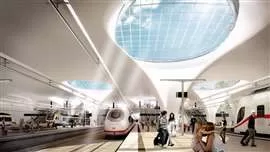Stuttgart 21 is one of the largest and most hotly-debated projects of new rail infrastructure in the world. It is for the development of the railway in the city of Stuttgart and for increasing linkages of the region of Baden-Württemberg and neighbouring regions. The construction of this project was implemented by Deutsche Bahn in 2010. This large scale redevelopment is currently costing around 9.79 billion euros which categories it as one of the largest infrastructure projects in Europe.
The main component of this project is the reconstruction of Stuttgart Hauptbahnhof from terminal station to through station. This current terminus formula forces trains to stop and reverse moves, which increases time and reduces traffic capacity tremendously. It will optimize the functioning of the train station by moving it underground and adding eight new tracks to it, all thanks to the Stuttgart 21. This design will help eliminate the need for trains to reverse at the station, which will make it easier to make faster connections to other cities such as Ulm, Munich among others.
Read also Meriaura Energy Clinches Agreement for Solar Thermal facility in Lübeck, Germany

Significance
Part of the new construction works is defined as increasing the capacity of the main station of Stuttgart, the construction of approximately 57 km new tracks, 59 km tunnels and over 40 bridges. The new tunnel will also link it to the new high speed line between Wendlingen and Ulm. This line has helped cut down the time it takes to make a trip between Stuttgart and Ulm to a mere 30 minutes, making transport in this region much more efficient.
In addition to the transport improvements, Stuttgart 21 will transform the structure of this city. This project will release 100 hectares of floor space currently used by the infrastructure of overground railway tracks.
Stuttgart 21 has heavy opposition from the environmentalists and locals. Since the emergence of this project there have been protests regarding the high costs of the project, the earlier delay in construction and the effects construction was having on the environment. People in this area have been concerned over the loss of open land with regard to the environment aspect as well as saturation or trenching.
Most of the tunneling works have been carried out and the last works predicted that the implementation of the project involves the last construction of the underground station and other infrastructure. This can be explained by the fact that upon its completion, Stuttgart 21 is expected to serve a significant part of the ongoing efforts to reform Germany’s rail transport system, articulate journey times and enhance regional mobility. On the same note, supporters of the project believe that adoption of the project will spur Stuttgart’s economic development by enhancing connectivity and improved urban planning.
Challenges faced
Stuttgart 21 has had to overcome a number of critical difficulties of technical as well as social nature. One major concern is high track gradient in the underground part of new station. The gradient of the tracks is 1.51 % while the maximum allowed gradient according to regs is 0,25 %. This has raised concerns in the safety of the station, and it functionality as a transport station. Hiking it could cause problems with controlling movement, for example, trains may start moving on their own, and concerns have been raised regarding the compliance of the new station design with the EU directive on rail safety.
Furthermore, the project’s implementation revealed large time lags and cost increases. As for the Thu Thiem New Urban Area in the Mekong Delta, the schedule was set for 2021, but due to revisions, it is set for 2025, and the cost about €8 billion, much higher than the first estimate. This problem translated to delays that were worsened by high construction costs owed to a flow growth in the construction market hence the need for reissuing tenders by the project managers.
The project also received massive protests from the public. Its introduction was followed by protests since some people believed it was planned and implemented without sufficient consult and that the redevelopment would be detrimental to historical Stuttgart Central Station. The project has also drawn concern from environmentalist and residents in the area who have protested against the destruction of green areas near the project and possibility of noise and pollution.
Project factsheet
Architect: Christoph Ingenhoven.
Constructor: Deutsche Bahn.
Start date: 2010.
Completion date: 2025.
Construction cost: Approximately €9.79 billion ($11 billion).
Location: Stuttgart, Germany.
Read also First ever UK-Germany energy link construction enters next phase

Leave a Reply